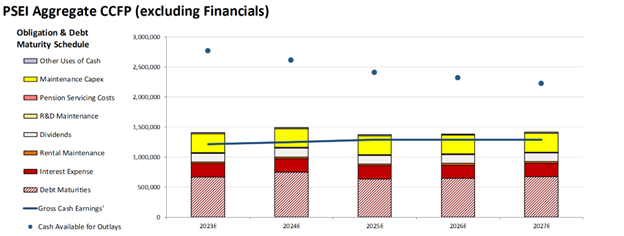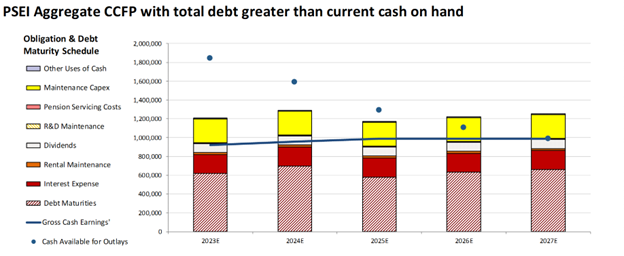PH Monday Macro: Biggest companies’ cash estimates are projected to be inadequate

With our macro and credit indicators, most of them point to the direction that the Philippine economy is currently robust. However, our credit model tells us that some of the largest companies in the country may face operational and debt challenges.
Today, we will explain what our proprietary model tells us.
Philippine Markets Daily:
The Monday Macro Report
Powered by Valens Research
To be a good equity analyst, you have to be a good credit analyst.
In starting a business, securing capital is crucial, and this capital typically comprises both equity and debt, as reflected in the balance sheet. These elements collectively constitute the creditworthiness of the company.
Not only do you need capital in the first stages of the business, but you need it more as a firm matures.
Due to the inherent limits of organic growth, companies often turn to credit to invest in assets to expand and potentially boost higher returns. So, examining a company’s credit provides insight into its management effectiveness and efficiency in utilizing credit for growth and profitability. It gives investors an in-depth understanding of the company’s operations and performance.
Credit has been used as a gauge since the 19th century to measure if a business is being run properly. When we talk about credit, we refer to the debt levels relative to the company’s cash flow.
Debt is not essentially a bad thing. Debt that yearly cash flows cannot cover, on the other hand, is a different story.
So by using such measurement, we are able to see if the management is making sure that they are not over-leveraged.
At Valens, we’ve developed a model that quantifies a company’s leverage. Take a look at it…

The chart displayed represents our proprietary credit model known as Credit Cash Flow Prime or CCFP.
Drawing from the Uniform Accounting methodology, CCFP provides a visual representation of a company’s cash flows (illustrated by the blue line) in relation to its financial responsibilities, which include debt maturation (the red diagonal line bar), debt-related interest (in solid red), and other operational obligations like maintenance capex (in solid yellow).
The chart offers an overview of the current aggregate CCFP for the PSEI 30, encompassing the largest publicly traded Philippine-based companies, excluding financial institutions because of their utilization of debt for growth and operations.
Over the next five years, debt maturities, corporate obligations, and projected cash flows are expected to remain nearly at the same levels.
Furthermore, while gross cash earnings are anticipated to fall short of total obligations and debt maturities, the total cash reserves are deemed sufficient to meet these commitments. This implies that the PSEI companies are forecasted not to face any material debt challenges.
However, for companies grappling with debt levels surpassing their current cash in hand, it signals concerns.

For these companies, 16 of 30 companies in the index, debt maturities start ramping up to the point where cash flows and expected cash reserves cannot support corporate obligations.
Cash flows are expected to come up short in meeting operating obligations for the next five years. Although the available cash will be enough to cover these obligations and debt until 2025, beyond that point, companies’ cash reserves will no longer be adequate.
What does this mean for the Philippine economy?
The pandemic compelled companies to restructure their debt with near-term maturities, extending these due dates that were once significant. This extension provided these companies with a longer timeframe to address potential refinancing challenges and liquidity crises caused by impending debt maturity headwalls.
As the CCFP presents average earnings estimates while incorporating certain Uniform Accounting standards adjustments, it is probable that the model will exhibit another trend due to the delayed reflection of the positive economic outlook in the company’s financial statements.
We will see in the next few months if the current positive sentiment will change the trend.
About the Philippine Markets Newsletter
“The Monday Macro Report”
When just about anyone can post just about anything online, it gets increasingly difficult for an individual investor to sift through the plethora of information available.
Investors need a tool that will help them cut through any biased or misleading information and dive straight into reliable and useful data.
Every Monday, we publish an interesting chart on the Philippine economy and stock market. We highlight data that investors would normally look at, but through the lens of Uniform Accounting, a powerful tool that gets investors closer to understanding the economic reality of firms.
Understanding what kind of market we are in, what leading indicators we should be looking at, and what market expectations are will make investing a less monumental task than finding a needle in a haystack.
Hope you’ve found this week’s macro chart interesting and insightful.
Stay tuned for next week’s Monday Macro report!
Regards,
Angelica Lim
Research Director
Philippine Markets Newsletter
Powered by Valens Research
www.valens-research.com




